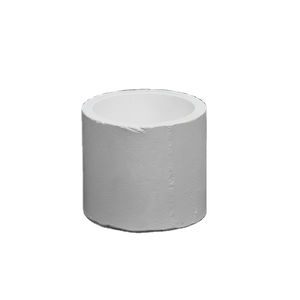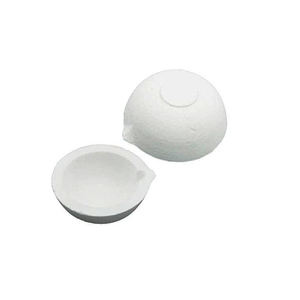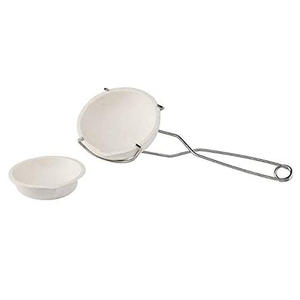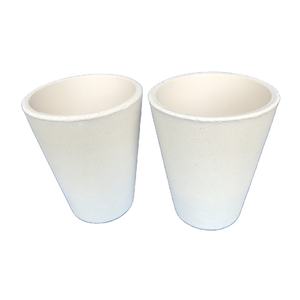Professional industry ceramic supplier, silicon nitride, silicon carbide, aluminum nitride and any other kinds of ceramics.
PRODUCT PARAMETERS
Description
Overview of Ceramic Crucibles Thermal Analyzer Alumina Ceramic Crucible
Ceramic Crucibles Thermal Analyzer Alumina Ceramic Crucible are specialized containers designed for withstanding extremely high temperatures in laboratory and industrial settings. They are essential for processes such as melting, calcining, and heat-treating a wide variety of materials, including metals, glasses, and chemicals. Our crucibles are engineered for superior thermal stability and chemical resistance, ensuring purity and reliability in the most demanding applications.
Features of Ceramic Crucibles Thermal Analyzer Alumina Ceramic Crucible
-
Exceptional Thermal Shock Resistance: Withstands rapid temperature changes without cracking, ensuring durability and a long service life.
-
High-Temperature Stability: Maintains structural integrity at extreme temperatures, often exceeding 1500°C.
-
Excellent Chemical Inertness: Resists corrosion and reaction with molten metals, acids, and aggressive chemical fluxes.
-
High Purity & Low Contamination: Manufactured from premium materials to prevent sample contamination during sensitive processes.
-
Optimized Thermal Properties: Designed for efficient heat transfer and consistent performance in furnace environments.
-
Robust Mechanical Strength: Offers good resistance to physical impact and abrasion during handling and use.
Specifications of Ceramic Crucibles Thermal Analyzer Alumina Ceramic Crucible
These ceramic crucibles are made for thermal analyzers. They hold samples during high temperature testing. Alumina ceramic is the main material. This material is very pure. High purity alumina is essential. It ensures consistent results. It prevents contamination of your sample. The crucibles withstand extremely high heat. They handle temperatures over 1700 degrees Celsius easily. This makes them ideal for demanding thermal analysis like TGA or DTA.
Crucibles come in different sizes. Common sizes fit standard thermal analyzer holders. Typical sizes include small volumes like 80 microliters or larger ones like 150 microliters. The exact size depends on the analyzer model. They are shaped like small cups. The design allows easy sample loading and removal. The walls are thin. Thin walls allow for fast heat transfer. This gives accurate temperature readings for your sample.
The ceramic surface is very smooth. A smooth surface prevents sample sticking. It also makes cleaning easier between uses. These crucibles are chemically inert. They do not react with most samples. This is crucial for reliable analysis data. You can use them repeatedly. They resist thermal shock well. Sudden temperature changes won’t easily crack them. This saves money over time. You don’t need to replace them often.
They are suitable for studying materials like polymers, metals, or chemicals under heat. Their high temperature stability is key. It allows observing material changes precisely. Choose the correct size for your specific instrument. Always check compatibility with your analyzer model.
Applications of Ceramic Crucibles Thermal Analyzer Alumina Ceramic Crucible
Ceramic crucibles are vital parts in thermal analysis equipment. They hold samples during heating or cooling tests. Alumina ceramic crucibles are very common. They work well for many thermal analysis methods. These crucibles handle very high temperatures. They resist sudden temperature changes. This makes them strong and reliable. Alumina ceramic is inert. It does not react with most chemicals. This prevents unwanted reactions with your sample. You get accurate test results. It has high purity. Low impurities mean less interference. Your data stays clean. Good thermal conductivity is another benefit. Heat spreads evenly through the crucible. Your sample heats uniformly. This is key for good measurements.
Alumina crucibles are used in many thermal techniques. DSC needs stable crucibles. It measures heat flow changes. TGA tracks weight changes with temperature. A solid crucible prevents errors. It withstands high temperatures easily. Crucible shape matters. Some designs suit specific instruments. Others fit different sample types. Pick the right one for your test. Crucibles must be clean before use. Any residue affects your results. Handle them carefully. Avoid chips or cracks. Damaged crucibles are not good. They can break during testing. Alumina ceramic crucibles are essential tools. They provide dependable performance. Your thermal analysis depends on them.
Company Profile
Tanki New Materials Co.Ltd. focus on the research and development, production and sales of ceramic products, serving the electronics, ceramics, chemical and other industries. Since its establishment in 2015, the company has been committed to providing customers with the best products and services, and has become a leader in the industry through continuous technological innovation and strict quality management.
Our products includes but not limited to Aerogel, Aluminum Nitride, Aluminum Oxide, Boron Carbide, Boron Nitride, Ceramic Crucible, Ceramic Fiber, Quartz Product, Refractory Material, Silicon Carbide, Silicon Nitride, ect. please feel free to contact us.

Payment Methods
T/T, Western Union, Paypal, Credit Card etc.
Shipment Methods
By air, by sea, by express, as customers request.
5 FAQs of Ceramic Crucibles Thermal Analyzer Alumina Ceramic Crucible
What are ceramic crucible thermal analyzers made from?
These crucibles are made from alumina ceramic. Alumina ceramic is a special type of ceramic. It contains aluminum oxide. This material is very strong. It can handle very high temperatures. It also resists chemicals well. This makes it perfect for thermal analysis.
How hot can these alumina ceramic crucibles get?
Alumina crucibles can withstand very high heat. They are typically rated for temperatures up to 1700°C. Some special types can handle even hotter conditions. They stay stable and do not melt. They handle quick temperature changes well. This is called thermal shock resistance.
Can I reuse an alumina ceramic crucible?
You can reuse them. They are designed for multiple uses. Check the crucible after each test. Look for cracks or damage. A damaged crucible might break next time. It could ruin your sample or equipment. Always inspect before reuse.
How do I clean my alumina ceramic crucible?
Cleaning is straightforward. Let the crucible cool down first. Never clean a hot crucible. Use a soft brush to remove loose residue. For tougher residue, soak it in a mild acid. A dilute nitric acid solution often works well. Rinse it thoroughly with water afterward. Let it dry completely before using it again.
Do these crucibles work with all thermal analyzers?
Most thermal analyzers use standard crucible sizes. Alumina ceramic crucibles come in common sizes. They fit most instruments. Check your analyzer’s manual. Confirm the exact crucible size and shape required. Using the wrong size will cause problems. It might not fit or give bad results.
REQUEST A QUOTE
RELATED PRODUCTS

Lab glassware Ceramics Core Crucible 30ml 40ml 60ml G1 G2 G3 G4 G5 Crucible Filter Sand Core Crucible

High Temperature Resistant Cordierite Mullite Sagger Alumina Ceramic Crucible for Glass Melting

Alumina Al2O3 Ceramic Porcelain Crucible 5ml-2000ml Cylindrical/Flat Bottom/Curved for Furnace Ceramic Parts

Development of 13ml Refractory Customized High Temperature Alumina Ceramic Crucible

Industrial Ceramic Crucible for Metal Melting and Casting



